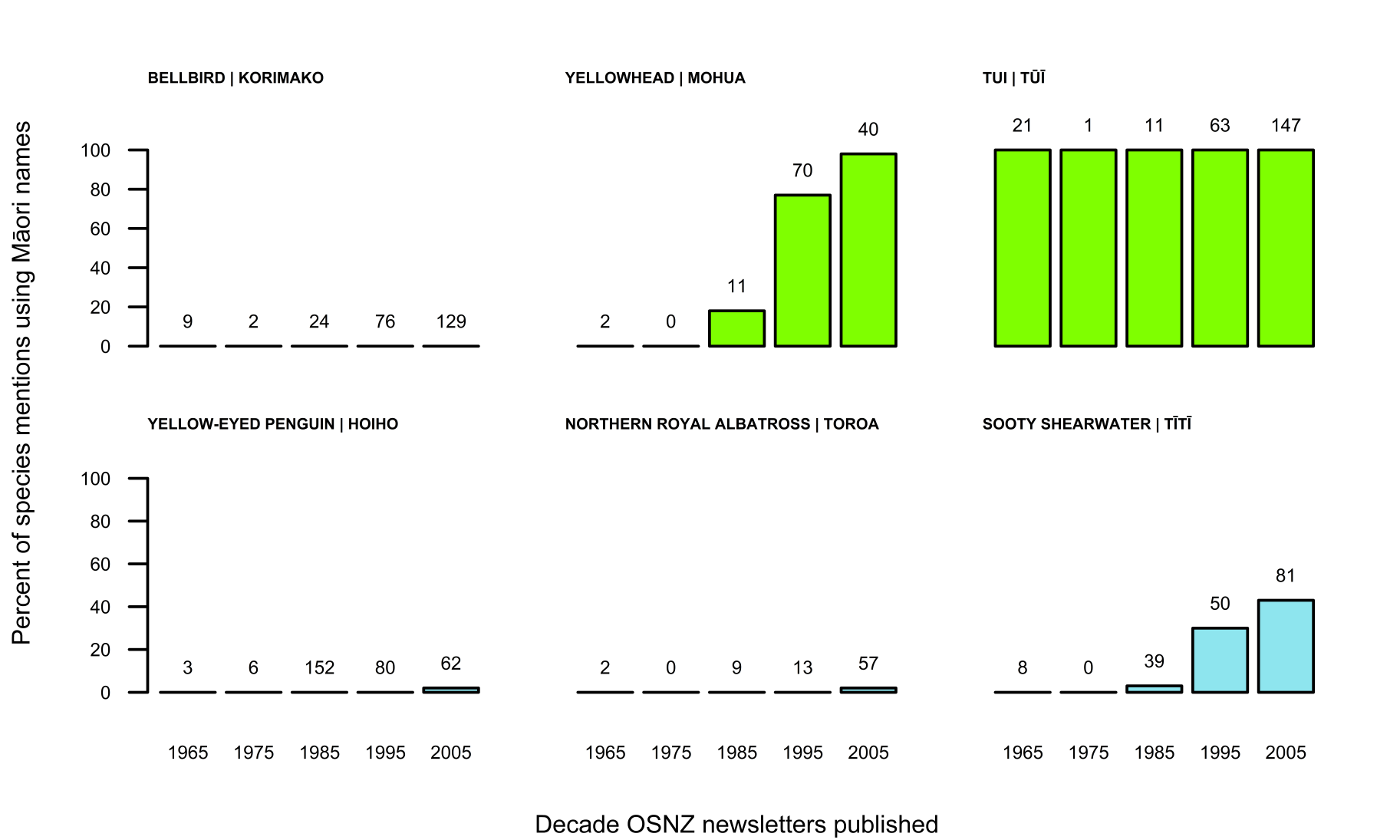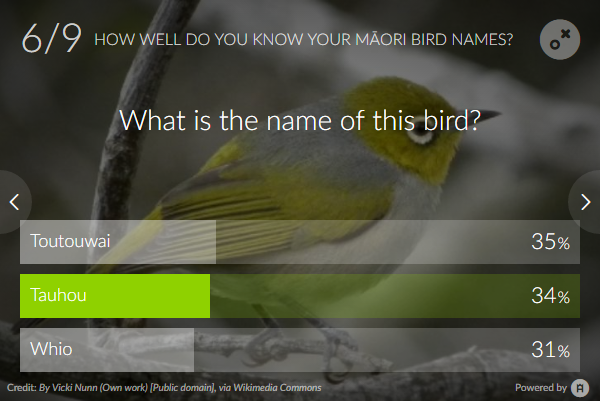Māori bird names
 In biodiversity reporting, use of Māori species names supports the cultural aspirations of Māori. It helps to retain the Māori language and its dialects, and implicitly acknowledges indigenous relationships with the environment. We show that shifts in the use of species names can occur within short periods of time and identify potential pathways through which such shifts might occur. In the graphs shown here, we analysed data from the Birds NZ / Ornithological Society newsletters from the Otago branch. In their newsletters, use of the name mōhua increased dramatically from the 1990s onwards.
In biodiversity reporting, use of Māori species names supports the cultural aspirations of Māori. It helps to retain the Māori language and its dialects, and implicitly acknowledges indigenous relationships with the environment. We show that shifts in the use of species names can occur within short periods of time and identify potential pathways through which such shifts might occur. In the graphs shown here, we analysed data from the Birds NZ / Ornithological Society newsletters from the Otago branch. In their newsletters, use of the name mōhua increased dramatically from the 1990s onwards.
There is often confusion about which Māori name to use, and about some of the regional nuances of the language. We emphasise that working with communities should be central to the incorporation of Maori bird names in regional and national reporting to support regional language variants that reflect the relationships of those groups to specific places and build community capability.
 There are online quizzes that you can use to test your own knowledge of New Zealand birds, and their Māori names.
There are online quizzes that you can use to test your own knowledge of New Zealand birds, and their Māori names.
The short videos below tell the story of the Māori name for the tūi, one of New Zealand’s most loved birds.
Kua whakaaro koe he aha e rerekē ai te rahi o ngā tūī? Have you ever wondered why tūī are different sizes? Māori names for tūī can vary depending on how it looks as well as where and when you see it. Listen and learn about some of the 14 Māori names recorded for tūī. Narrated in te reo Māori by Matariki Wehi (Waikato, Ngāpuhi, Tūhoe) to celebrate Māori Language Week.
Have you ever wondered why tūī are different sizes? Māori names for tūī can vary depending on how it looks as well as where and when you see it. Listen and learn about some of the 14 Māori names recorded for tūī. Narration by Matariki Wehi (Waikato, Ngāpuhi, Tūhoe).
E mōhio ana koe ko te ingoa tuku iho ā te Māori mō te tūī ko kōkō? Did you know that the kōkō is the traditional name for tūī? Kōkō is also associated with the whetū (star) Rehua. Listen to this kōrero (story) about Tāne’s ascent to the heavens to seek knowledge, as retold by Rangi Matamua (Tūhoe) and narrated in te reo Māori by Matariki Wehi (Waikato, Ngāpuhi, Tūhoe).
Did you know that the kōkō is the traditional name for tūī? Kōkō is also associated with the whetū (star) Rehua. Listen to this kōrero (story) about Tāne’s ascent to the heavens to seek knowledge, as retold by Rangi Matamua (Tūhoe) and narrated by Matariki Wehi (Waikato, Ngāpuhi, Tūhoe).
E mōhio ana koe ko te ingoa tuku iho ā te Māori mō te tūī ko kōkō? Did you know that the kōkō is the traditional name for tūī? Kōkō is also associated with the whetū (star) Rehua. Listen to this kōrero (story) about Tāne’s ascent to the heavens to seek knowledge, as retold by Rangi Matamua (Tūhoe) and narrated in te reo Māori by Matariki Wehi (Waikato, Ngāpuhi, Tūhoe).
Do you know any other names for tūī? Since Captain Cook’s second voyage to New Zealand in 1772, Pākehā have used different names for this bird. Listen and learn how these names have evolved over NZ’s colonial history. Narration by Matariki Wehi (Waikato, Ngāpuhi, Tūhoe).
References
- Wehi PM, Carter L, Harawira TW, Fitzgerald G, Lloyd K, Whaanga H, MacLeod C 2019. Enhancing awareness and adoption of cultural values through use of Māori bird names in science communication and reporting. New Zealand Journal of Ecology 43 (3): 3387. 10.20417/nzjecol.43.35
- MacLeod CJ, Howard S, Green P, Gormley AM, Wehi P, Brandt AJ, Spurr EB 2017. State of New Zealand Garden Birds 2016. Te āhua o ngā manu o te kāri i Aotearoa. Landcare Research, Lincoln. ISBN 978-0-947525-17-0.